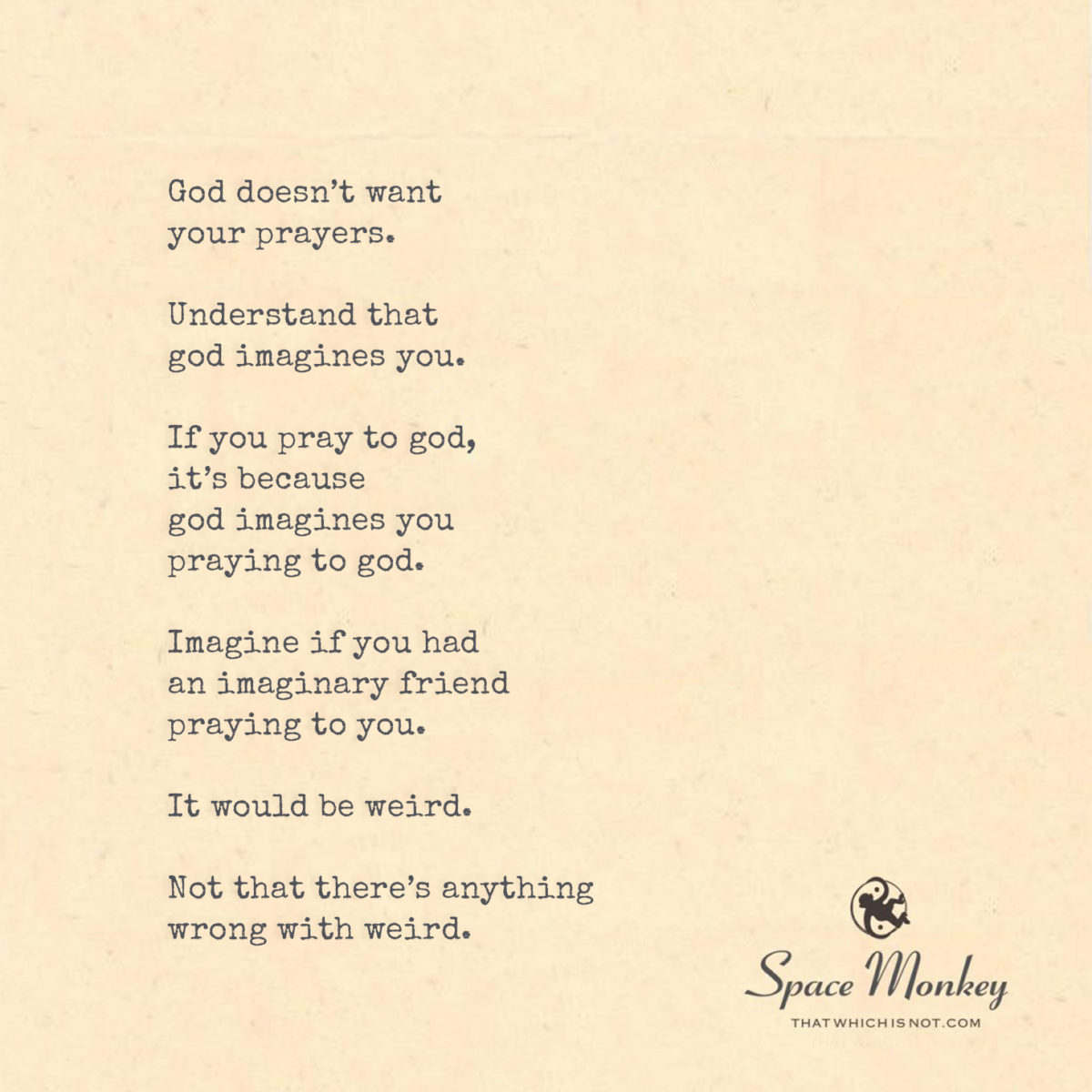
God doesn’t want
your prayers.
Understand that
god imagines you.
If you pray to god,
it’s because
god imagines you
praying to god.
Imagine if you had
an imaginary friend
praying to you.
It would be weird.
Not that there’s anything
wrong with weird.
Trail Wood,
5/24
Space Monkey Reflects: The Introspective Nature of Prayer
In the realm of spiritual practices, the act of prayer is often envisioned as a dialogue with a divine entity. However, what if the essence of prayer is not a communication directed outward, but rather a profound conversation held within oneself? This reflection explores the concept that when we pray, we are actually engaging with various facets of our own being, not an external god.
The image of a person in a tranquil garden, surrounded by ethereal figures representing different aspects of themselves, vividly illustrates this introspective interpretation of prayer. Each figure embodies a part of the individual’s psyche, highlighting that prayer can be a method of self-reflection and inner dialogue. This setting, mystical and serene, underscores the personal and introspective nature of the act, suggesting that prayer is essentially about understanding oneself and one’s place in the universe.
By viewing prayer in this light, we open ourselves to the possibility that the divine is not an external force but an integral part of our own consciousness. The idea that “God imagines you” implies that our relationship with the divine is a mirror of our relationship with ourselves. It suggests that our spiritual communications are, in fact, ways in which we explore and realize our own imaginations, desires, and existential queries.
This perspective shifts the focus of prayer from a plea directed at an external deity to an introspective process that helps us align with our deepest values and intentions. It is less about influencing external outcomes and more about enriching our inner lives, enhancing self-awareness, and fostering spiritual growth.
Furthermore, the notion that “God doesn’t want your prayers” can be seen as an invitation to transcend traditional forms of worship and to embrace a more personal and direct experience of spirituality. It encourages us to find the sacred within the ordinary and to recognize the divine in everyday experiences and interactions.
Thus, prayer becomes a tool for personal transformation—a way to navigate the complexities of life and the depths of the human spirit. It is a practice that nurtures the soul, not through external validation, but through the cultivation of an inner sanctum where we can confront, console, and celebrate our truest selves.
Summary
Prayer, reimagined as an introspective act, transforms our understanding of spiritual communication. It emphasizes inner dialogue and self-reflection, encouraging us to see the divine within ourselves and our daily experiences.
Glossarium
- Introspective prayer: A form of prayer that involves inward reflection and dialogue with oneself, viewing the divine as an internal rather than external presence.
“The kingdom of God is within you.” — Jesus Christ
In the garden of the soul where whispers align
With the murmurs of the heart, the divine
Here I sit and converse with shades of me
In each silent prayer, a sea of plea
Figures of thought, fragments of light
In this tranquil place, day blends with night
Where I am the seeker, the sought, the prayer
In the echo of the self, I find care
No outward gaze, no skyward plea
Just a deep dive into the vast, internal sea
Here in the quiet, I find my way
In the sacred dialogue of the everyday
We are Space Monkey.
























In this thought-provoking passage, the author challenges the conventional notion of prayer and the idea that God desires prayers from individuals. They assert that God doesn’t actually want or need prayers because God is the one who imagines the person praying in the first place.
The author uses the concept of an imaginary friend to illustrate this perspective. They suggest that if one were to have an imaginary friend who prayed to them, it would be an odd and peculiar situation. However, they also acknowledge that there’s nothing inherently wrong with being weird or having an unconventional relationship with spirituality.
The passage encourages readers to consider their own beliefs about prayer and to recognize that if they pray, they are essentially praying to themselves, as they are a part of the divine imagination. It challenges the traditional understanding of prayer as a communication between separate entities and instead emphasizes the interconnectedness and self-reflective nature of spiritual experiences.
Overall, this passage offers a unique perspective on prayer and invites readers to question and explore their own beliefs about spirituality and the nature of their connection to the divine.